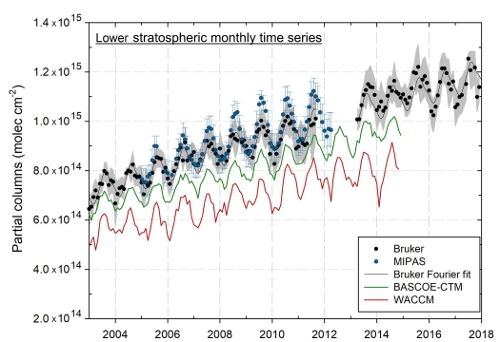MIPAS HCFC22 data help to validate ground based FTIR HCFC22 measurements from Jungfraujoch station

The figure presents the time series of monthly means of lower stratospheric partial columns (11.2 to 30 km) of HCFC22 measured by ground-based FTIR from Jungfraujoch (black dots are monthly means, the shaded area is the standard deviation of the monthly means). They are compared to MIPAS monthly means of measurements within 500 km around the Jungfraujoch station (blue dots). The blue bars are the standard deviations of the MIPAS monthly means. Also presented are results from two models, BASCOE CTM (green), and WACCM (red). The black line is the regression fit of the black data points which is dominated by a strong increase and a pronounced seasonal cycle.
Both the Jungfraujoch measurements and the MIPAS data present a pronounced seasonal cycle in the lower stratospheric HCFC22 data, and a strong increase. They agree very well with respect to the trend and the phase of the seasonal cycle. The seasonal amplitude is slightly higher for MIPAS; in particular, the seasonal peaks during summer are more pronounced than for the Bruker measurements from Jungfraujoch. However, the mean relative difference between Jungfraujoch Bruker measurements and MIPAS (−4.64±6.09%) is still within the range of the systematic error estimated for the Bruker measurements of 5 %. The seasonal cycle is mainly caused by young tropical air with higher HCFC22 abundances, flooding the extratropical lower stratosphere during boreal summer due to the weaker mixing barrier formed by the subtropical jet.
For more information see: https://doi.org/10.5194/acp-19-12309-2019
